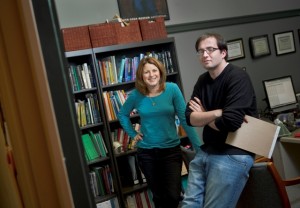
Susan Averett and Nick Stacey '11
Growing up in South Africa, Nick Stacey ’11 was well aware his country had an obesity problem, but he didn’t realize just how widespread it was until he began working on an EXCEL research project with Susan Averett, Dana Professor of Economics.
“It’s become an epidemic,” says Stacey, who presented the pair’s findings in February at the Eastern Economics Association annual conference in New York City.
Calculating the body mass index of 5,886 women and 3,768 men using height and weight measurements from the new National Income Dynamics Study, Stacey and Averett found that obesity is significantly more common in women than men and most prevalent among black and biracial women.
“There are differences along race lines,” says Stacey.
This is especially true for men, where the rate of obesity among Caucasians is more than double that of black and biracial men.
What’s notable about the pair’s research is the level of personal detail they were able to extract from the data, enabling them to break new ground on how factors such as income, marital status, education, geographic location, and even exercise impact weight among South Africans.
“We’ve not seen this depth of a study before in South Africa,” says Averett.
And although Averett and Stacey can’t explain why women are fatter than men, they do know it has little to with class status. On the contrary, BMI increases with socioeconomic status and that may have something to do with the perception that plumpness is a sign of health in a country where HIV, known as the “slim disease,” is a leading cause of death.
“Unlike the U.S., heavier people have a higher economic status in South Africa,” says Averett.
Having a significant other also has an effect on weight, the pair found. “Being partnered makes you more likely to be obese but it stops you from being very obese,” Stacey says.
That may be because cultural ideas about beauty, especially in black populations, consider being overweight an attractive feature. Obesity in women also reflects well on a husband’s ability to provide for his wife and family.
But being overweight comes with its own set of health problems, including heart disease and type 2 Diabetes, and the cost of dealing with the issue is going to be overwhelming in a country of 46 million people, says Stacey, who is from Johannesburg.
A double major in math and economics, Stacey plans to pursue a master’s degree in economics and credits Averett’s guidance with helping him win acceptance to Brown University, where he will pursue a Ph.D. in economics.
“I’ve had to put into practice a whole bunch of statistical techniques and come up with a research agenda, which you’re supposed to learn in grad school, but I’ve already done it,” he says.
Presenting original research to professional economists also gave him an edge in the application process, says Averett.
“He didn’t take a class,” she says. “He was my EXCEL Scholar and it was something he wanted to work on.”
Stacey chose the topic because, he says, he liked the idea of tackling a “social issue that hasn’t been focused on as much as I thought it should.”
Stacey not only did his share of research but helped write the paper that’s under review for publication at an economics journal. The pair plans to submit two more papers on the topic by the end of May.
“This is the kind of thing that would be harder to do at a larger school,” says Averett, who has won several awards for teaching and was the inaugural recipient of Lafayette’s James E. Lennertz Prize for Exceptional Teaching and Mentoring in 2004. “It represents the best of Lafayette and embodies all the opportunities that are open to students because we’re a strictly undergraduate institution.”
